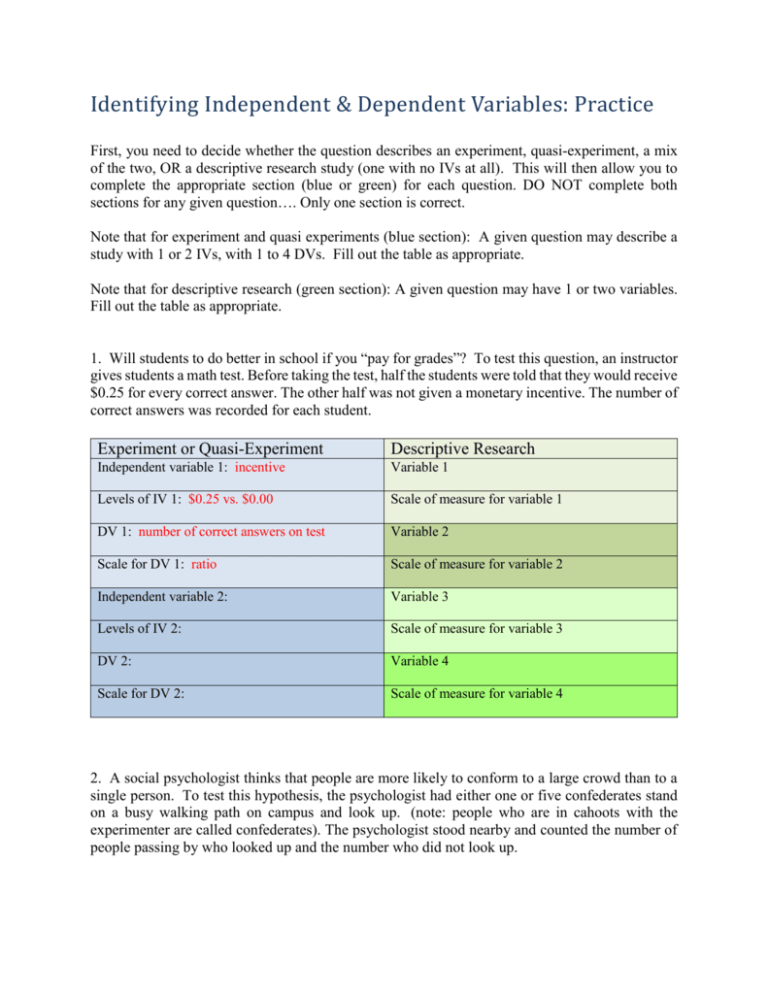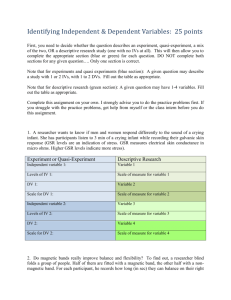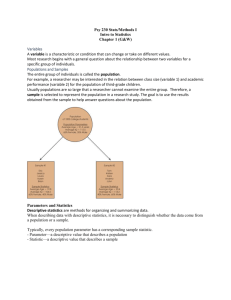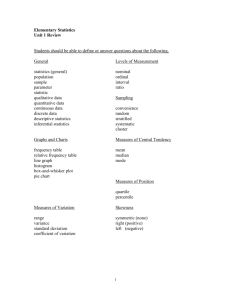practice question answers
advertisement

Identifying Independent & Dependent Variables: Practice First, you need to decide whether the question describes an experiment, quasi-experiment, a mix of the two, OR a descriptive research study (one with no IVs at all). This will then allow you to complete the appropriate section (blue or green) for each question. DO NOT complete both sections for any given question…. Only one section is correct. Note that for experiment and quasi experiments (blue section): A given question may describe a study with 1 or 2 IVs, with 1 to 4 DVs. Fill out the table as appropriate. Note that for descriptive research (green section): A given question may have 1 or two variables. Fill out the table as appropriate. 1. Will students to do better in school if you “pay for grades”? To test this question, an instructor gives students a math test. Before taking the test, half the students were told that they would receive $0.25 for every correct answer. The other half was not given a monetary incentive. The number of correct answers was recorded for each student. Experiment or Quasi-Experiment Descriptive Research Independent variable 1: incentive Variable 1 Levels of IV 1: $0.25 vs. $0.00 Scale of measure for variable 1 DV 1: number of correct answers on test Variable 2 Scale for DV 1: ratio Scale of measure for variable 2 Independent variable 2: Variable 3 Levels of IV 2: Scale of measure for variable 3 DV 2: Variable 4 Scale for DV 2: Scale of measure for variable 4 2. A social psychologist thinks that people are more likely to conform to a large crowd than to a single person. To test this hypothesis, the psychologist had either one or five confederates stand on a busy walking path on campus and look up. (note: people who are in cahoots with the experimenter are called confederates). The psychologist stood nearby and counted the number of people passing by who looked up and the number who did not look up. Experiment or Quasi-Experiment Descriptive Research Independent variable 1: confederates Variable 1 Levels of IV 1: one vs. five Scale of measure for variable 1 DV 1: whether the participant looked up or not Variable 2 Scale for DV 1: nominal Scale of measure for variable 2 Independent variable 2: Variable 3 Levels of IV 2: Scale of measure for variable 3 DV 2: Variable 4 Scale for DV 2: Scale of measure for variable 4 3. To test a new voice feature in a cockpit design, a flight simulator was used. The simulator was programmed to give visual readings of flight information, or to give visual and auditory (voice) readings of flight information. All test pilots were put through a simulated emergency landing procedure, but were randomly assigned to the visual, or visual and auditory conditions. Flight experts scored each pilot’s performance in the simulator on a scale of 1 (very poor) to 10 (excellent). Experiment or Quasi-Experiment Descriptive Research Independent variable 1: information Variable 1 Levels of IV 1: visual vs. visual + auditory Scale of measure for variable 1 DV 1: performance on a 1-10 scale Variable 2 Scale for DV 1: interval Scale of measure for variable 2 Independent variable 2: Variable 3 Levels of IV 2: Scale of measure for variable 3 DV 2: Variable 4 Scale for DV 2: Scale of measure for variable 4 4. A researcher was interested in the effects of reward on intrinsic motivation. Some children were told that they would be given a special award for drawing with magic markers (an activity they already enjoyed). Other children were simply asked to draw with the magic markers. One week later, the children were unobtrusively observed for how much time they spent drawing with the markers. The children who expected and received a reward for drawing with the markers spent less time drawing with them later. Experiment or Quasi-Experiment Descriptive Research Independent variable 1: reward Variable 1 Levels of IV 1: no reward vs. special reward Scale of measure for variable 1 DV 1: time spent drawing with markers Variable 2 Scale for DV 1: ratio Scale of measure for variable 2 Independent variable 2: Variable 3 Levels of IV 2: Scale of measure for variable 3 DV 2: Variable 4 Scale for DV 2: Scale of measure for variable 4 5. In an investigation of the fundamental attribution error, participants were given a speech to read that either favored or opposed Fidel Castro, the former communist leader of Cuba. Participants were told that the speech was written by a student who had been assigned to the position taken in the paper (that is, the student writing the speech had no choice on which position to take). Nevertheless, participants believed that the student who wrote the pro-Castro speech had positive attitudes toward Castro, while subjects who read the anti-Castro paper believed the writer had negative attitudes toward Castro. Attitudes toward Castro was measured on a 6 point Likert scale, where 1 = extremely negative and 6 = extremely positive. Experiment or Quasi-Experiment Descriptive Research Independent variable 1: Castro speech Variable 1 Levels of IV 1: pro-Castro vs. anti-Castro Scale of measure for variable 1 DV 1: attitude toward Castro on a Likert scale Variable 2 Scale for DV 1: interval Scale of measure for variable 2 Independent variable 2: Variable 3 Levels of IV 2: Scale of measure for variable 3 DV 2: Variable 4 Scale for DV 2: Scale of measure for variable 4 6. A researcher suspects that a newly discovered brain structure (the snookum) plays an important role in the desire to show affection. To test this, he administered a drug which inhibits the snookum. He tested 3 groups of people who received either: 0 mg, 5 mg, or 10 mg of the drug. He predicted that the more the snookum was inhibited, the less affection people would show (combined number of hugs and kisses to a cute, cuddly puppy). Experiment or Quasi-Experiment Descriptive Research Independent variable 1: drug dose Variable 1 Levels of IV 1: 0 mg vs. 5 mg vs. 10 mg Scale of measure for variable 1 DV 1: number of combined hugs and kisses Variable 2 Scale for DV 1: ratio Scale of measure for variable 2 Independent variable 2: Variable 3 Levels of IV 2: Scale of measure for variable 3 DV 2: Variable 4 Scale for DV 2: Scale of measure for variable 4 7. A researcher suspects that the amount of moisture in the air (% humidity) affects how quickly mold will grow. He measures the amount of moisture in the air every day for 1 month. On each day, he also measures how many new mold spores have formed. He finds that the more moisture there is in the air, the more mold spores formed. Experiment or Quasi-Experiment Descriptive Research Independent variable 1: Variable 1 % humidity in the air Levels of IV 1: Scale of measure for variable 1 ratio DV 1: Variable 2 number of mold spores Scale for DV 1: Scale of measure for variable 2 ratio Independent variable 2: Variable 3 Levels of IV 2: Scale of measure for variable 3 DV 2: Variable 4 Scale for DV 2: Scale of measure for variable 4 8. A soap manufacturer wants to show that their detergent (Suddsy-Clean) works better to remove tough stains compared to the leading brand (Tidey-Clean). To test this, 20 white t-shirts were purchased. On each t-shirt, 10 different types of stains were placed. Half the t-shirts were then washed with Suddsy-Clean, and the other half were washed with Tidey-Clean. Afterwards, the number of stains left on each t-shirt was recorded. Experiment or Quasi-Experiment Descriptive Research Independent variable 1: detergent Variable 1 Levels of IV 1: Suddsy-Clean vs. Tidey-Clean Scale of measure for variable 1 DV 1: number of shirt stains Variable 2 Scale for DV 1: ratio Scale of measure for variable 2 Independent variable 2: Variable 3 Levels of IV 2: Scale of measure for variable 3 DV 2: Variable 4 Scale for DV 2: Scale of measure for variable 4 9. An entomologist wants to determine if night temperature and the volume at which crickets chirp are related. She began the study at 10:00 pm when it was 75 degrees F outside. Every 20 minutes, she recorded the outside temperature and the crickets’ chirp volume (in dB). She ended the study at 5:00 am, after the temperature had dropped to 48 degrees F and the crickets had shut up. Experiment or Quasi-Experiment Descriptive Research Independent variable 1: Variable 1 outside air temp (degrees F) Levels of IV 1: Scale of measure for variable 1 interval DV 1: Variable 2 chirp volume in dB Scale for DV 1: Scale of measure for variable 2 ratio Independent variable 2: Variable 3 Levels of IV 2: Scale of measure for variable 3 DV 2: Variable 4 Scale for DV 2: Scale of measure for variable 4 10. Previous research has shown that playing music helps plants grow taller. But, does the type of music matter? Does the volume of the music matter? To test this, 1” seedlings were assigned to a specific music group (country, rock, classical). Then within each of these groups, the music was played at either a low, medium, or high volume. At the end of one month, the change in each plant’s height was recorded. Experiment or Quasi-Experiment Descriptive Research Independent variable 1: music type Variable 1 Levels of IV 1: country, rock, classical Scale of measure for variable 1 DV 1: plant height in inches Variable 2 Scale for DV 1: ratio Scale of measure for variable 2 Independent variable 2: volume Variable 3 Levels of IV 2: low vs. medium vs. high Scale of measure for variable 3 DV 2: Variable 4 Scale for DV 2: Scale of measure for variable 4 11. Harvester ants often strip a bush of all of its leaves. Some people believe this helps the plant grow thicker, healthier stems. To evaluate this claim, a student compared two sets of plants with stems of equal thickness. In set one, the plants were let alone. In set two, harvester ants were introduced and allowed stripped off all the leaves from the set of plants. The student measured the plants’ stem thickness (in mm) 6 months later. Experiment or Quasi-Experiment Descriptive Research Independent variable 1: plant environment Variable 1 Levels of IV 1: no ants vs ants Scale of measure for variable 1 DV 1: stem diameter in mm Variable 2 Scale for DV 1: ratio Scale of measure for variable 2 Independent variable 2: Variable 3 Levels of IV 2: Scale of measure for variable 3 DV 2: Variable 4 Scale for DV 2: Scale of measure for variable 4 12. Does watching aggressive team sports on TV increase aggression in the observer? To test this, half your participants watch a hockey game and the other half watch a team relay race. Immediately after, the participants are asked to sentence a hypothetical convicted felon to a jail sentence (# of months in prison). You infer that longer sentences equate with more aggression. Experiment or Quasi-Experiment Descriptive Research Independent variable 1: sport observed Variable 1 Levels of IV 1: hockey vs team relay race Scale of measure for variable 1 DV 1: length of sentence in months Variable 2 Scale for DV 1: ratio Scale of measure for variable 2 Independent variable 2: Variable 3 Levels of IV 2: Scale of measure for variable 3 DV 2: Variable 4 Scale for DV 2: Scale of measure for variable 4 13. You want to test a new drug that supposedly prevents sneezing in people allergic to grass. You randomly assign ½ the participants to the drug group and the rest to a placebo control. One half hour later, you have them sit in a room filled with the grass they are allergic to. You record the total number of sneezes over the next 30 minutes. Experiment or Quasi-Experiment Descriptive Research Independent variable 1: treatment group Variable 1 Levels of IV 1: placebo vs. drug Scale of measure for variable 1 DV 1: number of sneezes Variable 2 Scale for DV 1: ratio Scale of measure for variable 2 Independent variable 2: Variable 3 Levels of IV 2: Scale of measure for variable 3 DV 2: Variable 4 Scale for DV 2: Scale of measure for variable 4 14. Orchids were studied to determine if the amount of humidity (25%, 55%, 85%) affects the flowering of these plants. The researcher placed 20 four month old plants with no blooms on them in each of these humidity conditions. After 3 weeks, he recorded the total number of blooms on the 20 plants in each condition. Experiment or Quasi-Experiment Descriptive Research Independent variable 1: humidity level Variable 1 Levels of IV 1: 25% vs. 55% vs. 85% Scale of measure for variable 1 DV 1: number of blooms Variable 2 Scale for DV 1: ratio Scale of measure for variable 2 Independent variable 2: Variable 3 Levels of IV 2: Scale of measure for variable 3 DV 2: Variable 4 Scale for DV 2: Scale of measure for variable 4 15. Which method of wound closure produces the least noticeable scarring 12 weeks later: stitches, staples, or steri-strips? He randomly assigns 10 patients to each method. Degree of scaring is measured on a 6 point Likert scale, where 1 = no visible scar and 6 = extremely visible scar. Experiment or Quasi-Experiment Descriptive Research Independent variable 1: wound closure method Variable 1 Levels of IV 1: stiches vs. staples vs. steri-strips Scale of measure for variable 1 DV 1: degree of scaring on a Likert scale Variable 2 Scale for DV 1: interval Scale of measure for variable 2 Independent variable 2: Variable 3 Levels of IV 2: Scale of measure for variable 3 DV 2: Variable 4 Scale for DV 2: Scale of measure for variable 4 16. Which method of learning brain anatomy is more effective: using a coloring book for the brain or the rap song method. Students in the respective groups are scored on an anatomy test after using their method for 2 weeks. Experiment or Quasi-Experiment Descriptive Research Independent variable 1: learning method Variable 1 Levels of IV 1: coloring book vs. rap song Scale of measure for variable 1 DV 1: score on anatomy test Variable 2 Scale for DV 1: interval or ratio (either answer can be justified) Independent variable 2: Scale of measure for variable 2 Levels of IV 2: Scale of measure for variable 3 DV 2: Variable 4 Scale for DV 2: Scale of measure for variable 4 Variable 3 17. Is severity of depression related to the number of daily hassles a person experiences? To find out, a researcher gives each person a questionnaire to measure daily hassles, and another questionnaire to measure their level of depression on a 10 point scale (1 = no depression, 10 = maximal depression). Experiment or Quasi-Experiment Descriptive Research Independent variable 1: Variable 1 depression on a 10 point scale Levels of IV 1: Scale of measure for variable 1 interval DV 1: Variable 2 number of daily hassles Scale for DV 1: Scale of measure for variable 2 ratio Independent variable 2: Variable 3 Levels of IV 2: Scale of measure for variable 3 DV 2: Variable 4 Scale for DV 2: Scale of measure for variable 4 18. Within a classroom setting, students were asked to listen to a guest instructor. All students were given a description of the instructor before class. Some students read a description containing the phrase “People who know him consider him to be a rather cold person...”, while other people read a description where the word “warm” was substituted for the word cold (otherwise, the descriptions were identical). After the lecture, students were asked to evaluate the instructor. Subjects who were told the instructor was warm gave him more favorable scores compared to subjects who were told that the instructor was cold. Instructor evaluation was assessed using a 5 point Likert scale. Experiment or Quasi-Experiment Descriptive Research Independent variable 1: instructor description Variable 1 Levels of IV 1: warm vs. cold Scale of measure for variable 1 DV 1: instructor evaluation on a Likert scale Variable 2 Scale for DV 1: interval Scale of measure for variable 2 Independent variable 2: Variable 3 Levels of IV 2: Scale of measure for variable 3 DV 2: Variable 4 Scale for DV 2: Scale of measure for variable 4 19. Food deprived participants were brought into a room after the researcher measured their baseline blood glucose (BG) level (in dl/ml). Half of them looked at and smelled a warm chocolate brownie. The other half looked at and smelled a warm chicken breast. Ten minutes later, their BG level was reassessed and the researcher noted for each participant whether it increased, decreased, or remained the same. He then counted the number of people in each category combination to see whether the direction of BG change was related to the type of food presented to the participant. Experiment or Quasi-Experiment Descriptive Research Independent variable 1: type of food Variable 1 Levels of IV 1: brownie vs chicken Scale of measure for variable 1 DV 1: direction of BG change (decreased, 0, increased) Variable 2 Scale for DV 1: ordinal Scale of measure for variable 2 Independent variable 2: Variable 3 Levels of IV 2: Scale of measure for variable 3 DV 2: Variable 4 Scale for DV 2: Scale of measure for variable 4 20. Participants read about a woman who used a particular title, and then scored her on two traits. When the woman used the title Ms. rather than Miss or Mrs., she was assumed to be assertive, but also cold. Each of these “traits” was assessed using a Likert scale Experiment or Quasi-Experiment Descriptive Research Independent variable 1: title used Variable 1 Levels of IV 1: Ms. Vs. Miss vs. Mrs. Scale of measure for variable 1 DV 1: assertiveness on a Likert scale Variable 2 Scale for DV 1: interval Scale of measure for variable 2 Independent variable 2: Variable 3 Levels of IV 2: Scale of measure for variable 3 DV 2: coldness on a Likert scale Variable 4 Scale for DV 2: interval Scale of measure for variable 4 Note: your performance on the practice questions is a good predictor of your performance on the assignment. If you did not do well, please ask for help!









